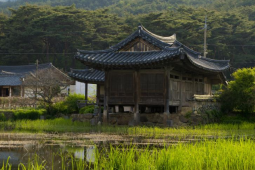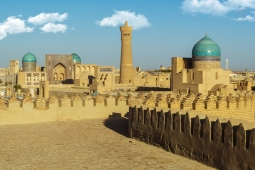Cultural Selection: The Diffusion of Tea and Tea Culture along the Silk Roads
©Kuzey Aytaç / UNESCO Youth Eyes on the Silk RoadsThe history of tea stretches back over thousands of years and spans not only the vast regions encompassed by the Silk Roads but much of the globe. It is well known that tea has been at the centre of intercultural exchanges taking place between European ports and the far Eastern regions of the Silk Roads from the 16th century CE onwards. However, tea, as well as its associated drinking culture, has been at the foreground of Silk Roads interactions stretching back much further to the earliest days of these routes. Tea is derived from the plant Camellia sinesis, and, although today there are numerous types of tea and many different ways of preparing and drinking it, whether black, oolong, green, or white, they all originate from this one plant. Camellia sinesis has a number of possible places of origin but it is generally accepted that it originates from Central Southeast Asia in the region at the intersection of what is today North East India, Northern Myanmar, and South West China.
Tea has been consumed in China for thousands of years with some of the earlies references to tea drinking on record dating from the Shang Dynasty (1500 BCE–1046 BCE), where It was consumed in Yunnan province primarily as a medicinal drink. By the Tang period (618- 907 CE), tea had become popular and was widely enjoyed as a refreshing beverage, prepared from leaves that had been moistened and shaped into a dense brick. Anecdotal evidence from the 8th century CE reports that the city of Chang-an had a large number of flourishing tea shops, many of which advertised the health benefits of tea drinking. Later, during the Song dynasty (960 – 1279 CE) the brick form of tea was replaced in popularity with loose leaves which were often ground into a fine powder and, increasingly, flavoured with different substances. Over time tea houses began to appear across large cities making tea more accessible outside of elite society. As it grew in popularity and accessibility, thanks to the development of sophisticated trade routes, tea became associated with homeliness, and was drunk daily as well as served to guests to welcome them. From China tea spread across the Eastern Silk Roads to Japan and the Korean Peninsula. In Japan, the beverage developed close connotations with religious and social rituals owing to the fact that it was commonly consumed by Buddhist priests. In the 6th century CE envoys were sent from Japan to China to learn about tea and its associated culture and seeds were imported via the Silk Roads in order for the plant to be cultivated in Japan.
Indeed, the dynamic exchanges and social rituals associated with tea were, and remain, important parts of everyday life and community. Tea soon became prominent in creative spheres, including within poetry and literature, as poets and artists wrote about the joy of tea and explored tea customs and associated traditions in their work. As a result, tea’s popularity quickly rose throughout the Eastern regions of the Silk Roads, in particular an aesthetic culture developed around tea drinking that achieved a considerable amount of notoriety in medieval Japan in the 14th and 15th centuries CE. The art of tea making, and drinking, was not only passed down through generations but was also diffused to the West and across various continents around the world. Ultimately, the tea trade spread from China and Mongolia to the Indian Subcontinent, Anatolia, the Iranian Plateau and beyond eventually reaching Europe and North Africa. Tea was also intricately linked to another flourishing Silk Roads trade that became the basis for a number of complex interactions within the arts, that of ceramics, and, specifically, porcelain. During the Ming dynasty (1368 – 1644 CE) tea-wares became a major art form and teapots and other ceramics were produced in various styles. Many of these ceramics were exported as desirable luxury trade items across the Silk Roads.
Although there are many regional variations, many cultures along the Silk Roads share tea drinking customs and traditions. Today, cultures and regions around the world have continued to adapt the ubiquitous product according to their own societal norms, with brewing processes, flavouring, and social rituals varying from place to place. Some examples of the different variations of tea found across the Silk Roads include ‘kahwa’ a tea popular in the northern Indian Subcontinent that is often served at special occasions such as weddings and festivals. It is prepared in a samovar with added cardamom, cinnamon, almonds and saffron. In what is today Afghanistan, an elaborate tea called ‘qymaq chai’ is prepared for special occasions such as weddings and engagements, it is pinkish in colour with added milk and cardamom. The British and Dutch also incorporated the beverage into their lifestyles, where it developed connotations linked to hospitality, mutual understanding, local tradition, and community.
The complex intercultural exchanges associated with tea and tea culture were the direct result of the movement of traders, missionaries, and physicians along the Silk Roads. As they travelled across the vast regions of Eurasia, different elements of culture were transmitted both to the East and the West. Tea culture is just one excellent example of the new imports and social practices that were often later transformed and reconceptualized according to the specificities of the societies into which they were introduced. The effects of this free flow of ideas, goods, and artistic elements along the Silk Roads constitutes an important shared heritage in the contemporary world.
See Also

Intercultural Design Elements in Relief Sculpture from Silla, the Korean Peninsula
From the 7th century onwards the city of Gyeongju, the capital of Silla during the Three Kingdoms (57 BCE – 668 CE) and later Unified Silla (668 – 935 CE) periods, developed to become a major trade centre in the Korean Peninsula.

Architectural Design in Urban Centres along the Silk Roads from the 7th to the 14th century CE
Cities and urban centres flourished along the Silk Roads passing through the Central Asian regions of Khorasan (in present-day North East Iran) and Transoxiana (a portion of Central Asia, that includes parts of present day Uzbekistan, Tajikistan, southern Kyrgyzstan and southwest Kazakhstan) between the 7th and 14th centuries CE.






